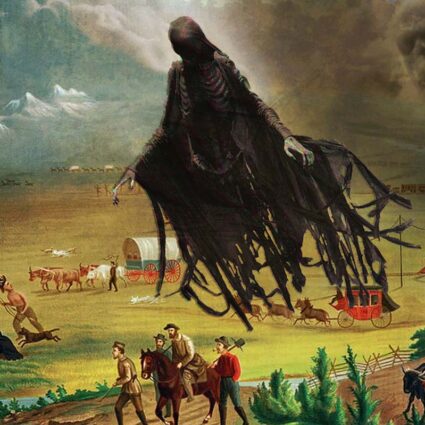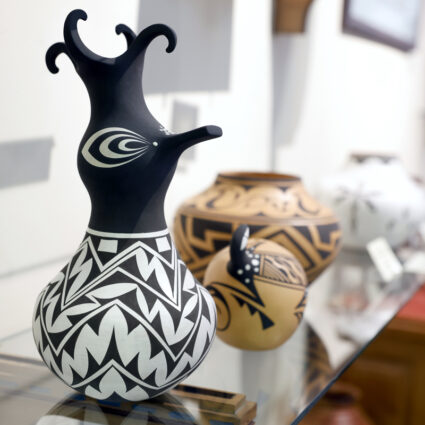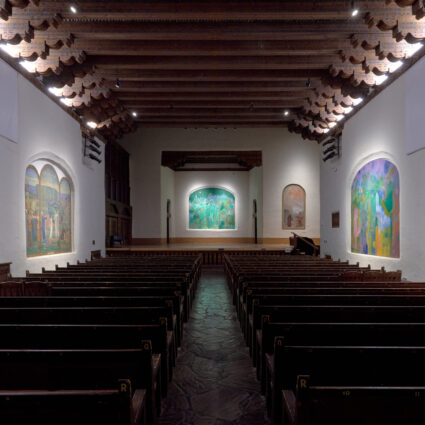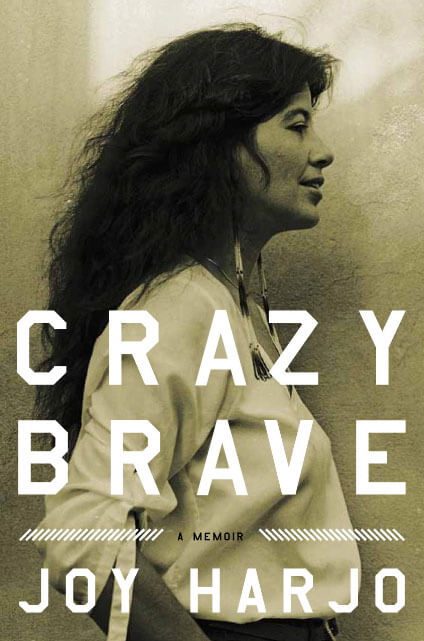
Jenn Shapland: How did your time in New Mexico impact your work? Do you think of yourself as a New Mexico writer, in part?
Joy Harjo: I still feel like a New Mexico writer in part, an important part, and my plans are to secure a little place there to live at least part of the time. My children are there with their families. Most of my grandchildren are there. I came to Santa Fe as a high school student at the Institute of American Indian Arts in the late sixties. I was there during the time of the contemporary native art revitalization that changed everything in the art world. It was an exciting time to be at IAIA. Even we younger high school students knew we were in the middle of a crucial time in Indian country politics and thought. We were part of the generational current in which we were thinking about culture sovereignty, before sovereignty was a common word on our tongues. I was admitted on the basis of my drawings. I took no writing classes and had no thought of becoming a writer, though I did write song lyrics.
I returned to Oklahoma after graduating from high school, gave birth to a son, and returned to New Mexico to reclaim a life with artistic possibilities. I worked several jobs in Santa Fe, including pumping gas in a mini skirt on Cerrillos Road, to becoming a nursing assistant and working shifts at the old St. Vincent’s Hospital on Palace Avenue. I was admitted to the University of New Mexico as a pre-med major, and by second semester I was back in the art studio.
By my second year as a studio art major, I had discovered poetry. I had always been a lover of poetry and just happened to be in “the right place at the right time,” as the saying goes, when it comes to Native literature. The “American Indian literary renaissance” was just beginning with N. Scott Momaday, Leslie Silko, James Welch, and Simon Ortiz. The Living Batch Bookstore in Albuquerque hosted many of these poets, and the University of New Mexico English Department had an active series. I got to hear Ai, Anne Waldman, Galway Kinnell, and so many others. I was a member of the Native student club, the Kiva Club, which started out as a social club for Native students, and turned into a center for political action for Native rights.
Poetry is a tool for the kind of disruption needed to clean a wound and heal.
All this inspired me, and I began writing poetry because it was a way to speak about what was happening within our Native communities. I used to frequently draw and photograph the Sandia Mountains and carried an image of the Jemez Mountains in one of my jeans’ pockets. I loved the way they arch red into the blue sky when you’re driving from Bernalillo. The mountains were a doorway to blue imagination. They still are—New Mexico inspires me as no other place. I consider it the birthplace of my poetry, though of course, my poetry was set in place for generations, through all the speakers, singers, and artists in my ancestral lines. There are many—from tribal chiefs, painters, to back porch guitarists.
What is the role of poetry today? Why do you keep writing poems?
I believe the role of poetry is what it has always been: our hearts get broken again and again but can be put back together again with poetry. It is the art closest to music. It trumps rhetoric. Can carry grief, ecstasy, celebration, despair, or joy. It is a tool for the kind of disruption needed to clean a wound and heal. It predicts how we will know who we are in forthcoming generations. Without it, we will no longer be human.
I keep writing poems because it is a kind of calling, one I didn’t actually choose. I was in an art path. I loved painting and photography. Poetry first came to me through music. My very early years are marked by my mother’s song-making and love of poetry. I loved poetry but had no intention of becoming a poet. It came upon me and essentially asked me to take care of it. Poetry has become my most demanding teacher, one that I honor, with poetry and music.
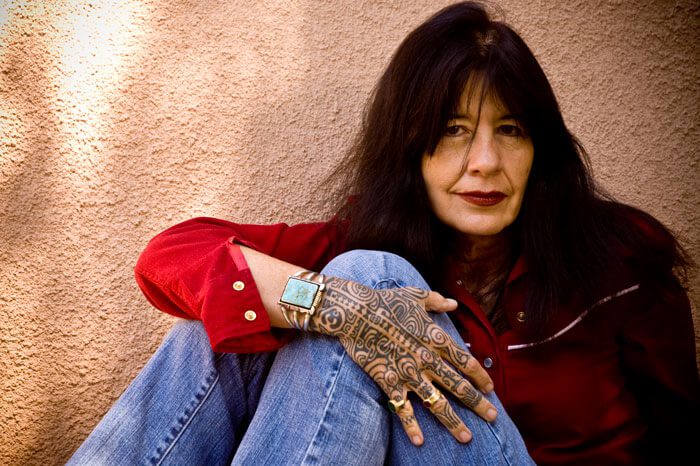
Your poems often seem to express a radical form of compassion, for others and also for the self. Tell me about the role of compassion in your work.
Compassion is the motherland, our point of departure and our return. Compassion is a constant teacher, always righting us wherever we venture. Being indigenous in stolen lands affects all aspects of lives, for Native and non-Natives, because it forms the base and basis of what it means to be a citizen here. Poetry is my teacher. When I follow it, it shows me the way through craft and inspiration in poetry, music or whatever art that opens up meaning. I believe that all of our pathways, as they wind through the profane and the sacred, are meant to open us to compassion. If there are past lives, they are not past, they are present and future. Eventually we become everyone, will see through the eyes of all beings. Then we will truly know who we are . . .
Who are your touchstones? Who would you include in a survey of North American poetry, and why? What is your canon?
“Funny you ask” . . . I have been working for a year on a Norton Anthology of Native Poetry. (We don’t have the title yet.) I secured a team that includes Native poets and students of mine at the University of Tennessee. We have now been working on it for a year. Unlike Heid Erdrich’s wonderful collection of Native poetry released this year, New Poets of Native Nations from Graywolf Press, this anthology is an historic one. We reach back as far as possible and move forward into the newest and upcoming poets. We’ve had quite a task. We have quite a restricting page limit, so that has been a challenge. We can’t include everything that we believe should be included in such a collection. What I’ve enjoyed most is reading poets and poems I have loved through the years and discovering poets I didn’t know from more recent and through all time. I always shy away from naming favorite poets and made the mistake of including a list of Native poets in a poem in my last book of poetry. I’d like to delete that list in future book editions, because that act of naming is too tricky. We are really in this endeavor together, each generation, one after the other. Of course, there are some poets and poems that become reference points. Leslie Silko’s witchery poem in her novel, Ceremony, is one of them; Simon Ortiz’s book, From Sand Creek, which is essentially a long poem written while healing in a VA hospital from an illness whose roots lead back to the butchery that occurred at Sand Creek and his Acoma Pueblo home. There’s Layli Long Soldier’s “38” poem; Tommy Pico’s “Nature Poem”; Diane Burns; Nora Dauenhauer; dg nanouk ookpik; Rex Lee Jim, who writes mostly in Navajo; and poems from the sixties’ collections of student poems from the Institute of American Indian Arts.
